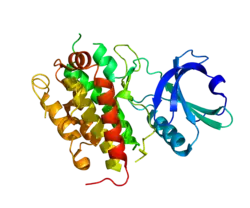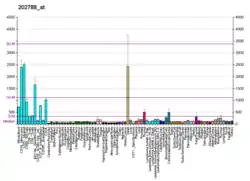MAPKAPK3
MAP kinase-activated protein kinase 3 is an enzyme that in humans is encoded by the MAPKAPK3 gene.[5][6][7]
Function
This gene encodes a member of the Ser/Thr protein kinase family. This kinase functions as a mitogen-activated protein kinase (MAP kinase)- activated protein kinase. MAP kinases are also known as extracellular signal-regulated kinases (ERKs), act as an integration point for multiple biochemical signals. This kinase was shown to be activated by growth inducers and stress stimulation of cells. In vitro studies demonstrated that ERK, p38 MAP kinase and Jun N-terminal kinase were all able to phosphorylate and activate this kinase, which suggested the role of this kinase as an integrative element of signaling in both mitogen and stress responses. This kinase was reported to interact with, phosphorylate and repress the activity of E47, which is a basic helix-loop-helix transcription factor known to be involved in the regulation of tissue-specific gene expression and cell differentiation.[7]
References
- GRCh38: Ensembl release 89: ENSG00000114738 - Ensembl, May 2017
- GRCm38: Ensembl release 89: ENSMUSG00000032577 - Ensembl, May 2017
- "Human PubMed Reference:". National Center for Biotechnology Information, U.S. National Library of Medicine.
- "Mouse PubMed Reference:". National Center for Biotechnology Information, U.S. National Library of Medicine.
- McLaughlin MM, Kumar S, McDonnell PC, Van Horn S, Lee JC, Livi GP, Young PR (June 1996). "Identification of mitogen-activated protein (MAP) kinase-activated protein kinase-3, a novel substrate of CSBP p38 MAP kinase". J Biol Chem. 271 (14): 8488–92. doi:10.1074/jbc.271.14.8488. PMID 8626550.
- Sithanandam G, Latif F, Duh FM, Bernal R, Smola U, Li H, Kuzmin I, Wixler V, Geil L, Shrestha S (June 1996). "3pK, a new mitogen-activated protein kinase-activated protein kinase located in the small cell lung cancer tumor suppressor gene region". Mol Cell Biol. 16 (3): 868–76. doi:10.1128/mcb.16.3.868. PMC 231067. PMID 8622688.
- "Entrez Gene: MAPKAPK3 mitogen-activated protein kinase-activated protein kinase 3".
- Tanoue T, Maeda R, Adachi M, Nishida E (February 2001). "Identification of a docking groove on ERK and p38 MAP kinases that regulates the specificity of docking interactions". EMBO J. 20 (3): 466–79. doi:10.1093/emboj/20.3.466. PMC 133461. PMID 11157753.
- Neufeld B, Grosse-Wilde A, Hoffmeyer A, Jordan BW, Chen P, Dinev D, Ludwig S, Rapp UR (July 2000). "Serine/Threonine kinases 3pK and MAPK-activated protein kinase 2 interact with the basic helix-loop-helix transcription factor E47 and repress its transcriptional activity". J. Biol. Chem. 275 (27): 20239–42. doi:10.1074/jbc.C901040199. PMID 10781029.
Further reading
- Wei MH, Latif F, Bader S, Kashuba V, Chen JY, Duh FM, Sekido Y, Lee CC, Geil L, Kuzmin I, Zabarovsky E, Klein G, Zbar B, Minna JD, Lerman MI (1996). "Construction of a 600-kilobase cosmid clone contig and generation of a transcriptional map surrounding the lung cancer tumor suppressor gene (TSG) locus on human chromosome 3p21.3: progress toward the isolation of a lung cancer TSG". Cancer Res. 56 (7): 1487–92. PMID 8603390.
- Clifton AD, Young PR, Cohen P (1996). "A comparison of the substrate specificity of MAPKAP kinase-2 and MAPKAP kinase-3 and their activation by cytokines and cellular stress". FEBS Lett. 392 (3): 209–14. doi:10.1016/0014-5793(96)00816-2. PMID 8774846. S2CID 45549489.
- Ludwig S, Engel K, Hoffmeyer A, Sithanandam G, Neufeld B, Palm D, Gaestel M, Rapp UR (1997). "3pK, a novel mitogen-activated protein (MAP) kinase-activated protein kinase, is targeted by three MAP kinase pathways". Mol. Cell. Biol. 16 (12): 6687–97. doi:10.1128/mcb.16.12.6687. PMC 231671. PMID 8943323.
- Kumar S, McDonnell PC, Gum RJ, Hand AT, Lee JC, Young PR (1997). "Novel homologues of CSBP/p38 MAP kinase: activation, substrate specificity and sensitivity to inhibition by pyridinyl imidazoles". Biochem. Biophys. Res. Commun. 235 (3): 533–8. doi:10.1006/bbrc.1997.6849. PMID 9207191.
- Neufeld B, Grosse-Wilde A, Hoffmeyer A, Jordan BW, Chen P, Dinev D, Ludwig S, Rapp UR (2000). "Serine/Threonine kinases 3pK and MAPK-activated protein kinase 2 interact with the basic helix-loop-helix transcription factor E47 and repress its transcriptional activity". J. Biol. Chem. 275 (27): 20239–42. doi:10.1074/jbc.C901040199. PMID 10781029.
- Tanoue T, Maeda R, Adachi M, Nishida E (2001). "Identification of a docking groove on ERK and p38 MAP kinases that regulates the specificity of docking interactions". EMBO J. 20 (3): 466–79. doi:10.1093/emboj/20.3.466. PMC 133461. PMID 11157753.
- Simkhovich BZ, Abdishoo S, Poizat C, Hale SL, Kedes LH, Kloner RA (2002). "Gene activity changes in ischemically preconditioned rabbit heart gene: discovery array study". Heart Disease (Hagerstown, Md.). 4 (2): 63–9. doi:10.1097/00132580-200203000-00002. PMID 11975836.
- Knebel A, Haydon CE, Morrice N, Cohen P (2002). "Stress-induced regulation of eukaryotic elongation factor 2 kinase by SB 203580-sensitive and -insensitive pathways". Biochem. J. 367 (Pt 2): 525–32. doi:10.1042/BJ20020916. PMC 1222910. PMID 12171600.
- Zakowski V, Keramas G, Kilian K, Rapp UR, Ludwig S (2004). "Mitogen-activated 3p kinase is active in the nucleus". Exp. Cell Res. 299 (1): 101–9. doi:10.1016/j.yexcr.2004.05.027. PMID 15302577.
- Voncken JW, Niessen H, Neufeld B, Rennefahrt U, Dahlmans V, Kubben N, Holzer B, Ludwig S, Rapp UR (2005). "MAPKAP kinase 3pK phosphorylates and regulates chromatin association of the polycomb group protein Bmi1". J. Biol. Chem. 280 (7): 5178–87. doi:10.1074/jbc.M407155200. PMID 15563468.
- Rual JF, Venkatesan K, Hao T, Hirozane-Kishikawa T, Dricot A, Li N, Berriz GF, Gibbons FD, Dreze M, Ayivi-Guedehoussou N, Klitgord N, Simon C, Boxem M, Milstein S, Rosenberg J, Goldberg DS, Zhang LV, Wong SL, Franklin G, Li S, Albala JS, Lim J, Fraughton C, Llamosas E, Cevik S, Bex C, Lamesch P, Sikorski RS, Vandenhaute J, Zoghbi HY, Smolyar A, Bosak S, Sequerra R, Doucette-Stamm L, Cusick ME, Hill DE, Roth FP, Vidal M (2005). "Towards a proteome-scale map of the human protein-protein interaction network". Nature. 437 (7062): 1173–8. Bibcode:2005Natur.437.1173R. doi:10.1038/nature04209. PMID 16189514. S2CID 4427026.






